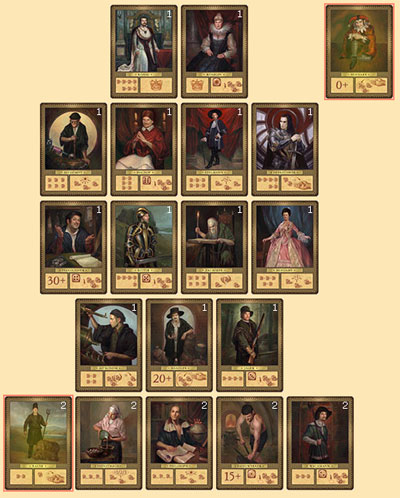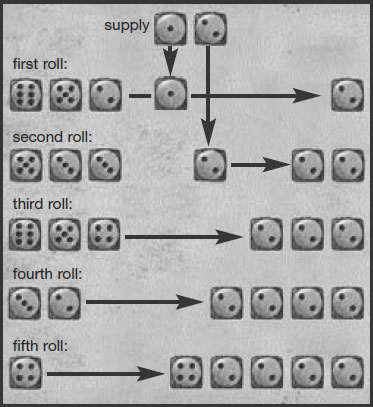To Court The King

CONTENTS
60 character cards, 1 start player figure, 12 dice, 5 summary cards
As a royal petitioner attending court, the players must parlay
their powers of persuasion to gain the support of court officials
and sway the King to their cause.
The players’ persuasive powers, in a constantly shifting court,
are represented by dice. Each starts with three dice. Each turn,
a player rolls the dice, sets aside at least one die, and re-rolls
the rest until he has set all his dice aside. With these dice, if
they form an appropriate pattern, a player may obtain an
character card, giving him another die or a special power. The
first player to roll seven of a kind gains the King’s support and,
possibly, victory!
The support of the King (and Queen) is often the difference in
the final roll-off, which determines the winner!

Only with five players are all character cards used in the game.
When playing with fewer than five players, use the table below to
determine how many of each character card will be used. The
numbers are based on the roman numerals on the back sides of
the cards. For example, in a two-player game, the player use 2
Laborers, 2 Farmers, and so on. The number of Fool/Charlatan
cards is considered unlimited.
| ROW | 2 Players | 3 Players | 4 Players | 5 Players |
| I | 2 | 2 | 3 | 4 |
| II | 1 | 2 | 3 | 3 |
| III/IV | 1 | 2 | 2 | 3 |
| IV | 1 | 1 | 1 | 1 |
Place the cards in rows in the middle of the table as shown
below. The position of the cards within a row plays no role in the
game, but each row has only cards with the same back side (see
figure below).
Cards with I on the back side can be acquired with just three
dice, cards with II on the back require four dice, and so on.
The players choose a start player using any method they prefer.
He takes three dice and the start player figure.
The start player begins and takes his turn, then the other players
follow in clockwise order. On a player’s turn, he takes three dice
and rolls them. The just-rolled dice are the active dice. The player
must now set aside at least one of the active dice. If there are any
dice left after setting aside those he wishes, he may roll those left
again. These rolled dice are now the active dice and he must,
again, set aside at least one of them. The player continues in this
way until he has set aside all dice he is allowed to roll.
At the end of the player’s turn, the set aside dice represent his
dice result. With this dice result, the player may acquire a
character card from the character card display. Per turn, the
player may only acquire one character card, only one that is still
in the display, and only one that he does not already have in his
play area (the only exception to this is the Fool/Charlatan, see also
“Description of Character Cards” on page 8). Of course, the dice
result must match the cost for the card acquired.
Example: Suzanne’s dice result is 5-5-5. With this dice result, she
has several possibilities. She can acquire either a Farmer (cost:
one pair), a Laborer (cost: pip total of 15 or more), or a Guard
(cost: triplet). She chooses a Guard, takes the card, and places it
face up in her play area.
Some character cards, such as the Farmer, provide extra dice the
player must roll at the start of his turn. Others, such as the
Laborer, provide extra dice that the player may bring into play only
after he has made his initial roll. After his initial roll, which must
include extra dice like the one from the Farmer, a player may use
his other character cards at any time during his turn to modify
active dice or to bring new dice into play, either before, after, or in
between setting aside one or more active dice. A player may only
use each character once per turn! To indicate a card has been
used, the player should rotate it 90 or 180 degrees to show it has
been used on this turn. After a player’s turn, he should return all
used cards to their normal face orientation.
For all character card abilities, players should remember one
General Rule: only active dice can be modified by the ability of
a character card. Once a die has been set aside, it may not be
modified or re-rolled.
The costs and abilities of the character card are described ingame. After his
turn, the player returns all his used character cards to their
normal orientation to make them available for his next turn.
When all players have taken a turn in the round (the player to the
right of the start player has just finished his turn), the start player
gives the start player figure to the player on his right and this
player immediately begins the next round as the new start player.
Thus, the player to last roll in one round will be the first to roll in
the next round - taking two turns in a row. After a player finishes
his turn, play normally continues in a clockwise direction, but this
clockwise flow is interrupted each time the turn would return to
the start player. When this happens, the start player’s right
neighbor becomes the new start player and so on.
When all the character cards of a certain type have been acquired,
no player may acquire such a card for the rest of the game.
ABILITIES OF THE CHARACTER CARDS IN AN EXAMPLE
The abilities of the character cards allow a player to either bring
new dice into play or modify one or more active dice. The
following should help players better understand the way these
cards can be used (please have a summary card available to
refer to while reading this example).
 Suzanne has the following character cards: Laborer, Guard,
and Astronomer.
Suzanne has the following character cards: Laborer, Guard,
and Astronomer.
First roll: she rolls 6-5-2. She sets the 2 aside, uses the
Laborer to bring in a new die with value 1 from the supply as
an active die and rolls again.
Second roll: 5-3-3. She
uses the Guard to bring in
a new die with value 2 from
the supply as an active die,
sets it aside, and rolls
again.
Third roll: 6-5-4. She uses
the astronomer to modify
one of the active dice to
match the set aside dice:
to make it a value 2 die,
sets it aside, and rolls
again.
Fourth roll: 3-2. She sets
the 2 aside and rolls again.
Fifth roll: 4. She sets it aside (as she must set one aside).
Her dice result is 4-2-2-2-2.
With this dice result, Suzanne acquires a Hunter, which costs
four of a kind, and places the card face up in her play area.
When a player achieves a dice result of seven of a kind, he may,
but need not, acquire the King card and, thereby, initiate the end
of the game. He may, however, choose another card that his dice
result allows and the game continues normally. Should the player
choose to acquire the King, he also takes the Queen.
When a player acquires the King, the current round continues until
its normal end. Of course, no other player, regardless of roll, can
acquire the King and Queen (as they are gone from the display).
Then follows the final round. As normal, it begins with the player
to the right of the previous round’s start player. However, the
player with the King card skips his normal turn and rolls last in the
final round.
In this final round, each player tries, on his turn, to roll as high a
dice result as he can, always trying to roll better than the player
holding the King card. Players note their rolls.
Note: the more dice of a kind the better (e.g. eight 1’s is better
than seven 6’s). With the same number of dice of a kind, the
higher the number the better, of course. When two players have
rolled the same number of a kind with the same number on the
dice, the player who rolled the dice result first takes precedence.
The player with the current highest dice result takes the King card
(to show he has the highest), but not the Queen card.
The player with the Queen card has the ability to roll an extra die
and roll last in the final round, which give him great advantages!
When this player rolls, he also has the advantage that he need
merely match, not better the current best dice result to win the
game. If he does not do that, the player who currently holds the
King card (he has the best dice result) is the winner!
Example: Anna, Bob, Carl, and Doris are playing (and sitting in
this playing order at the table). Bob rolls seven 2’s and takes the
King and Queen, adding them to his play area. As Anna is the start
player for this round, Carl and Doris each have one turn to finish
before the final round begins, and they do so.
Now, the players begin the final round. Doris begins and rolls eight
1’s, which is higher than 7 2’s (the result the King was first claimed
with) and takes the King card as she has the current highest dice
result. Anna does not roll, as she has but seven dice and, thus,
could not beat Doris’ dice result. Carl rolls eight 3’s and takes the
King card, as his roll is higher than Doris’. Finally, Bob rolls last
and gets eight 4’s, winning the game!
→ Timing is the most important tactic in the game: players must choose when to use their card abilities.
→ When choosing which cards to buy, extra dice are very important, especially for the final round.
→ Hold the Ctrl key and click on a die to select all dice OTHER THAN the die value clicked.
→ Hold the Shift key and click on a die to select ALL OTHER DICE than the one clicked.